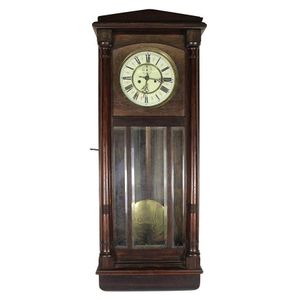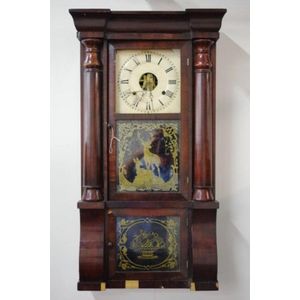19th Century Seth Thomas Wall Clock, Weight Driven
You must be a subscriber, and be logged in to view price and dealer details.
Subscribe Now to view actual auction price for this item
When you subscribe, you have the option of setting the currency in which to display prices to $Au, $US, $NZ or Stg.
- Pendulum - The pendulum was discovered around 1602 by Galileo Galilei, and was adopted for time keeping by the Dutch mathematician and natural philosopher, Christiaan Huygens, who excelled in astronomy, physics, and horology.
The pendulum comprises a metal rod usually of brass or steel with a metal disk, known as a bob, at the end. The movement of the pendulum is driven by weights or a spring, and as a pendulum swings in a regular arc, it was found accuracy could be controlled to within a few seconds a week.
Timekeeping can be adjusted by changing the height of the bob on the rod, making the pendulum either swing slower or faster.
The disadvantage of the pendulum was that changes in temperature also changed the length of the pendulum, interfering with the accuracy of the clock, and so in the 18th century two types of mercurial pendulums were invented which countered the movement in the steel rod.
The pendulum was the world's most accurate timekeeping technology until the invention of the quartz clock, regulated by a quartz crystal, in 1927. - Movement - The technical name for the workings of a clock or watch, and does not include the dial or case.
This item has been included into following indexes:
Visually similar items

Gustav Becker timber wall clock with key, pendulum & weights. Length 97 cm

A George III flame mahogany long case clock, by Thomas Walker, Strathaven, 222 cm high

A tall carved oak Brittany single door cabinet. 204 cm high, 60 cm wide, 47 cm deep.

A George III ornate marquetry inlaid oak longcase clock, by Jacob Lovelace of Exon (Exeter), the brass dial with silvered chapter ring enclosing the subsidiary seconds dial and date aperture, the eight day movement striking on a bell, the case with profuse
